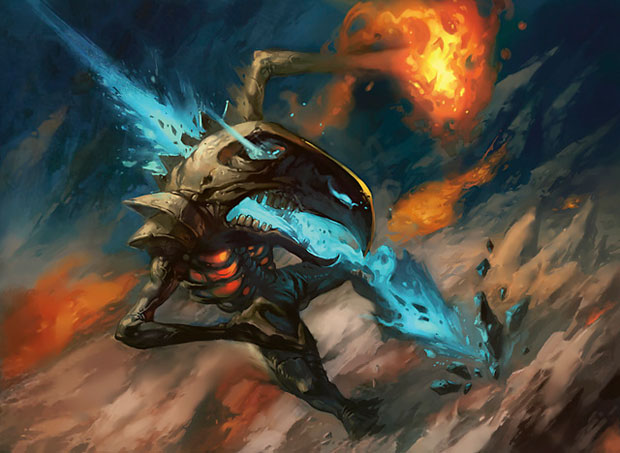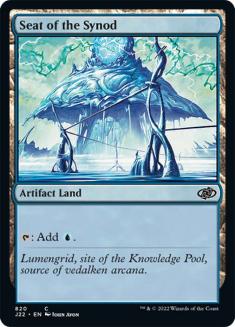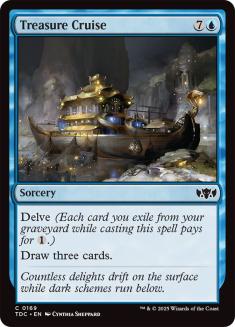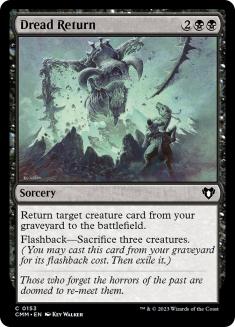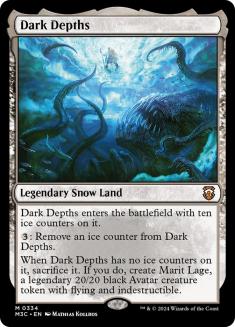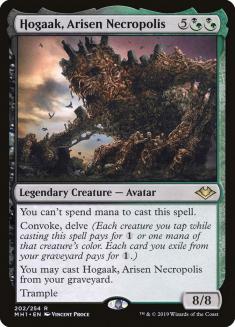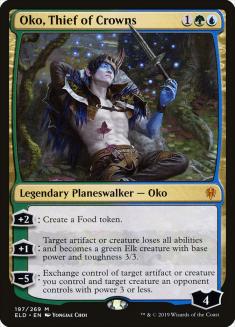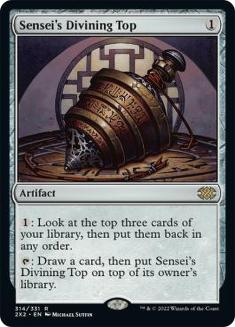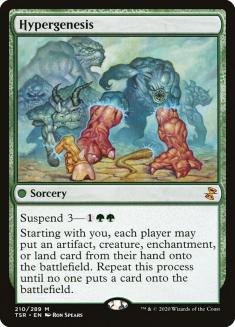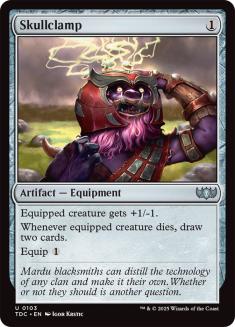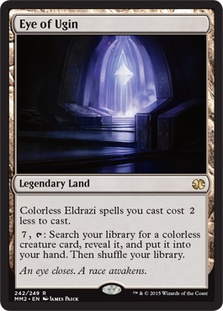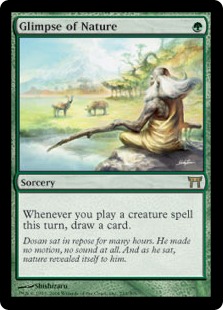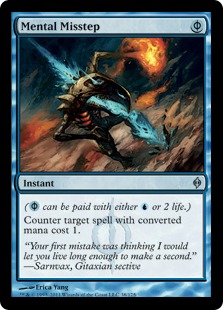Modern has reached stabilization. The decks are fun and the format is full of exquisite gameplay. There are plenty of distinct archetypes and nothing really feels oppressive. At this point, I think it’s safe to say that Modern Horizons 2 was a huge success on multiple fronts. With equilibrium comes complacency, and I’ve been hearing some buzz on Twitter about some potential unbans to shake things up.
While there are some cards that I do believe could come off the banned list, there’s a subset of cards that I would deem “untouchable.” These cards are brazenly overpowered and/or completely rip the game to shreds, all at little to no cost. Modern is getting long in the tooth, so I think it’s important to remind this new generation of players that some things are better left alone.
So join me as we drift through Magic’s sordid past and examine the eight most dangerous villains on Modern’s ban list.
In Memoriam
For a long time, I thought it was pretty clear that artifact lands were a huge problem. Too many cards in Magic’s history benefit from having random artifacts around, including Mox Opal. As long as Mox Opal was legal, the artifact lands couldn’t exist. With the banning of Mox Opal, I think that’s changed. Sure, you could go ahead and build 2004 Affinity with Disciple of the Vault and Thoughtcast, and it might just end up being another deck. At this stage, I don’t even know if it would make Affinity into a Top 10 strategy. It might not even be the best artifact deck!
With that said, Affinity is quite a powerful deck in Pauper, a format that’s historically more degenerate than Modern. Maybe cards like Frogmite and Sojourner’s Companion get a lot better, but then it just starts to feel like a different aggro deck. There’s some danger to an aggro deck that gets to play Thoughtcast and Thought Monitor though, as they won’t be vulnerable to traditional interaction. This is kinda what happened originally, as Affinity was able to grind through interaction thanks to the bursts of card advantage.
Overall, I think unbanning these would be a net negative, but they’re not untouchable. Mox Opal was the real culprit when Modern was first released, even if the artifact lands themselves were part of a dark time in Magic’s past.
These two cards are legal in Pioneer and have been relatively fine considering how unhinged they can be given the right surrounding cast. As long as fetchlands remain legal in Modern, these two cards cannot be. They warped Legacy so deeply, with Pyroblast becoming a heavy maindeck staple, they made their mark on Standard as two of the most powerful card draw spells ever printed, and I would never consider unbanning them in Modern unless fetchlands were to get the axe.
Free spells are some of the most dangerous in all of Magic’s history. Alternate costs are often cheated or undermined to farm an excessive advantage. Dread Return is no different, focusing entirely on milling your whole graveyard to allow free creatures and ultimately a free-ish Zombify. The problem, for a long time, was that the alternate cost of sacrificing three creatures was actually a benefit, creating multiple Zombies via Bridge from Below. The primary target for Dread Return was Flamekin Zealot, a random uncommon from the original Ravnica set that could give all those Zombies haste and end the game on the spot.
Without Bridge from Below in the mix, there’s a chance Dread Return isn’t all that threatening, but a free reanimation spell for deck like Dredge is extremely powerful. It’s one thing to get a big battlefield advantage for just casting Cathartic Reunion. It is quite another to cast Cathartic Reunion, mill over half your deck, then cast Dread Return for free, putting some giant lock piece like Iona, Shielf of Emeria onto the battlefield. Entire archetypes would spawn attempting to and successfully breaking Dread Return, even without Bridge from Below. However, without Bridge from Below in the mix, Dread Return could function as originally intended.
Honorable Mention
When the SCG Tour ran their No Ban List Modern Open at SCG CON a few years back, one of the decks that floated to the top in heavy-ish numbers was Dark Depths. Not only does it work with the tried and true Vampire Hexmage, but now you also have Thespian’s Stage to easily create a 20/20 indestructible. Being able to generate a threat that big without casting a spell is a huge red flag for a Magic card, and easily ranks in my Top 9 of untouchable banned cards. It just missed the list, but I would wager this one never gets unbanned. Lands are just too hard to interact with, and too easy to tutor up.
I have some horrible and wonderful memories of playing with and against Dark Depths back in the day. My first Grand Prix Top 8 was because of Dark Depths. It has only gotten stronger with Thespian’s Stage and I doubt it will ever be safe to unban unless Wasteland or similar gets printed into Modern. In the No Ban List Modern Open, this monstrosity took third.
Creatures (4)
Lands (23)
Spells (33)

And now for the main event!
8. Hogaak, Arisen Necropolis
Hogaak, Arisen Necropolis was printed in June of 2019 and didn’t make it to the end of the summer. It was banned along with Bridge from Below and Faithless Looting across multiple sessions as they tried to curtail one of the most degenerate decks of all time. Hogaak, Arisen Necropolis could be cast from the graveyard relatively easily, and was a way to self-sustain Altar of Dementia to mill your entire library with a Bridge from Below. It felt impossible to answer permanently, cost the pilot zero cards worth of investment, and was virtually unmatched in combat.
The first time I saw it in print, I was scared it would bring the whole format down. With Altar of Dementia, you added an entirely new element to the deck that didn’t exist before: the ability to win outside of combat. When your primary win condition is attacking with Vengevine, having a two-mana artifact that mills your opponent while doing triple duty as a graveyard enabler and sacrifice outlet was outrageous.
Creatures (28)
- 4 Carrion Feeder
- 4 Bloodghast
- 4 Vengevine
- 4 Gravecrawler
- 4 Insolent Neonate
- 4 Stitcher's Supplier
- 4 Hogaak, Arisen Necropolis
Lands (18)
Spells (14)
Sideboard

This deck warped Modern for a short time before getting the axe. It was evident to anyone playing with or against Hogaak that it was on another plane of existence. The fact that you could cast it for free from the graveyard was simply ludicrous. Playing against the deck was so polarizing, as the only real way to interact with it was keeping the entire graveyard exiled at all times. That meant Leyline of the Void or Rest in Peace, but those were easily countered with sideboard cards. Even if you could keep them in check for a minute or two, it would usually require mulliganing to your anti-graveyard card, and occasionally losing to the world’s most humiliating beatdown plan.
This one is relatively fresh in people’s mind so I doubt I need to go hard on convincing you it can’t be touched. Pound for pound, Hogaak, Arisen Necropolis might be the best creature ever printed. It has no place being legal in Modern ever again, and the fact that it was made in a supplemental product, Modern Horizons, makes me wish it didn’t exist in the first place.
7. Oko, Thief of Crowns
Before I die, I’m going to take every copy of Oko, Thief of Crowns and bury them in a landfill like they did with the E.T. game. Oko ravaged every Magic format for almost a year before getting banned in just about every one of those same formats. It is easily the best planeswalker of all time and offers up the least exciting gameplay ever conceived.
Oh cool, you put an Emrakul, the Aeons Torn onto the battlefield through a complex interaction? It’s an Elk now. Sorry.
Oh dang did you mean to play Ghalta, Primal Hunger? Or did you mean Elk?
While that aspect in and of itself isn’t necessarily the reason for its banning, it certainly contributes to the negative experience the card creates. The fact that it only ticked up, created game objects that could trade up for life points or be turned into threats, on top of invalidating your opponent’s entire strategy, made it one of the most reviled cards ever printed.
There is no “one decklist” that exemplifies what Oko, Thief of Crowns was all about. Instead, let me show you a deck that Twitch Chat built that went 5-0 in a Magic Online Pioneer league.
Creatures (19)
- 2 Dryad Militant
- 2 Loxodon Smiter
- 1 Armada Wurm
- 4 Voice of Resurgence
- 2 Fleecemane Lion
- 1 Ephara, God of the Polis
- 2 Deputy of Detention
- 1 Hydroid Krasis
- 4 Hero of Precinct One
Planeswalkers (9)
Lands (22)
Spells (10)

Imagine getting to play with a card so powerful that it allowed you to play Armada Wurm in the same format as Treasure Cruise. Good riddance.
6. Sensei’s Divining Top
“Time Thief” is a term I use to describe a person who plays slowly, or a card that burns large amounts of time in a game of Magic. Sensei’s Divining Top is notorious for encouraging the owner to use it multiple times per round. When you combine it with Counterbalance, you get a double whammy of sorts: a time thief that also soft-locks your opponent.
Counterbalance and Sensei’s Divining Top have existed together in multiple formats, including Standard at one point. That combination is not fun to play against, and requires a lot of game actions to play optimally, which in turn causes huge spans of the game where one person is taking the majority of game actions. While that isn’t necessarily grounds for expulsion, the combination of taxing time and causing undesirable gameplay is enough to pull the plug.
Any card that is banned in Legacy should rarely be considered safe for Modern, and especially so when the combination that got it banned in the first place exists in its unfettered form. If you want to know what a truly disgusting Counter-Top list looks like in Modern, check out BBD’s version from the No Ban List Modern Open from 2018.
Creatures (4)
Planeswalkers (2)
Lands (20)
Spells (34)

Counter-Top was never legal in Modern, so its hard to generate a litmus test for what it would actually look like. In the right context, it’s a central lock piece in a control deck that hinders the development and success of any archetype that emphasizes one and two-mana spells. It’s like a one-sided Chalice of the Void that also lets you manipulate your deck through fetchlands. It’s the second most annoying card ever printed (behind Rhystic Study).
5. Hypergenesis
While they’ve printed plenty of cards that function on the same wavelength as Hypergenesis, they have yet to make one as disgusting as Hypergenesis itself. The sheer force at which Hypergenesis decks hit the battlefield is staggering, even if the deck itself requires a lot of sacrifices in deckbuilding and the like. Free spells like Force of Negation would give it a bit of insulation from interaction, and I expect modern day versions would look and act similarly to Living End, albeit with a much more powerful end game.
Hypergenesis was another card banned before it was ever legal in Modern, but it existed in a space known as Extended for quite some time. All it takes is playing against it once before you realize just how easily it outclasses what everyone else is doing. Imagine getting to play twelve copies of Show and Tell, except they allow you to play your entire hand. When your hand and deck are full of Emrakul, the Aeons Torn and Griselbrand, you can start to see the problem.
Cascade allows you to cast those types of spells too easily for my taste. It’s palatable when the spell requires a lot of hoops to jump through to create that huge advantage, or the spell you’re casting does some whacky stuff like Warp World. When you spend three mana for fifteen or more mana worth of threats, then you start to see the problem. When you can still cast spells as normal, like all the current builds of Cascade decks, it creates a snowball effect. I could easily see a Hypergenesis deck featuring huge multicolor threats and a lot of copies of Solitude and/or Fury.
Creatures (26)
- 4 Elvish Spirit Guide
- 4 Simian Spirit Guide
- 4 Progenitus
- 4 Emrakul, the Aeons Torn
- 4 Griselbrand
- 2 Maelstrom Wanderer
- 4 Shardless Agent
Lands (16)
Spells (18)
Sideboard

The Modern versions of Hypergenesis would probably look something like this. Gemstone Caverns would be a four-of, as Simian Spirit Guide is no longer with us. Force of Will becomes Force of Negation, and a few other changes to the payoffs would likely result in a monstrosity that focuses on cheating Omniscience onto the battlefield to get the cast trigger from Emrakul, the Aeons Torn. Either that or it becomes some bastardization of Elementals and uses a bunch of the incarnations to play Free Spell Magic™ until you can resolve Hypergenesis to put some card draw engine or gamebreaker onto the battlefield.
It creates such a polarization in gameplay and interaction that nothing good would ever come of taking this off the banned list. Plenty of viable alternatives already exist and are thriving.
Before we continue, I just want to take a moment and really stress these last four cards. Of everything potentially legal in Modern, these last four are something else entirely. Their impact was so format warping that I can’t see a universe where any of them are okay to unban. Without further ado, here are Modern’s untouchables.
4. Skullclamp
I have had Skullclamp a bit higher on previous lists. It has only become more dangerous with Stoneforge Mystic and Puresteel Paladin. I can’t fathom a format that would allow Skullclamp to exist because it’s just such a heinous design. Not only does it punish the opponent for interacting, but it gives the controller a card draw engine for any deck featuring one-toughness creatures.
I played multiple formats for months with Skullclamp legal, and it was one of the darkest times in Magic’s history. The decks of the day were Skullclamp Goblins, Skullclamp Elves, and Skullclamp Affinity. I would stop playing any format where this card was legal, because it invalidates interaction. A single mana to cast and equip means you can chain off killing your own creatures while also protecting your bigger threats from removal. Even if your opponent kills the creature, who cares? You replace it with two fresh cards and start again the next turn.
The combo potential of Skullclamp exists, but isn’t the defining factor. Skullclamp is broken because it can do both and the opportunity cost for doing so is just “play creatures with one toughness alongside some sort of mana engine.” That’s it. Why on Earth is that okay to print?
Creatures (20)
Lands (18)
Spells (22)
Sideboard

When someone says the word Affinity in regards to a Magic deck, this is where it began. It outclassed every other Standard deck by a mile and dominated Mirrodin Block Constructed. The people who played Magic back then remember this format as one of the most damaging to the game. Skullclamp was the first Standard bannings in years. It never saw the light of day in Modern or Extended. It will never see play in another format outside of Vintage again.
3. Eye of Ugin
Eye of Ugin is up there for most degenerate cards ever printed, but it didn’t have an immediate effect. When it was first printed, the go-to Eldrazi were all expensive hulking monstrosities, and Eye of Ugin was used more to search them up than cheat them onto the battlefield. With Oath of the Gatewatch came a ton of cheap Eldrazi, supercharging this land that only saw play as a singleton in Mono-Green Tron. The Eldrazi creatures were all aggressively costed because they forced you to play colorless only. The reduction granted by Eye of Ugin made casting multiple over the course of the first two or three turns a foregone conclusion.
If all the Eldrazi creatures were like Matter Reshaper, I don’t know if it would have been banned. The all-star of the Eldrazi deck was always Thought-Knot Seer. Casting it on the second turn is disgusting because it adds a large body and takes your opponent’s best card. On the second turn, it can be quite difficult to interact with a 4/4 that takes your removal spell.
When Eye of Ugin was legal, the Modern format devolved into different forms of Eldrazi trying to beat each other up. It was clear that both lands that tapped for two mana were somewhat problematic, but having two of them was just too much. It didn’t help that Eye of Ugin’s cost reduction allowed for casting multiple creatures on the first turn, all of which could grow when you cast bigger Eldrazi. It was powerful enough that using the mulligan rule to find it was worthwhile, even if you started every game on five cards. That extra mana boost was just too much for most people to handle.
Creatures (26)
- 4 Simian Spirit Guide
- 2 Spellskite
- 4 Endless One
- 4 Eldrazi Mimic
- 4 Reality Smasher
- 4 Thought-Knot Seer
- 4 Matter Reshaper
Lands (24)
Spells (10)
Sideboard

There are few times throughout Magic’s long history where I can confidently say that someone “broke it.” This is one of those times. Eldrazi took 6/8 Top 8 slots, with the only opponent being Affinity. Can you imagine playing a tournament where only about thirty people know about a given archetype before the tournament begins and yet six of them flood the final rounds?
When SCG ran the No Ban List Modern Open, Eldrazi won the whole thing. What a disaster. This would be like if Steamflogger Boss was just chilling for over a decade, then one day they make some cool contraptions and assembling two-for-one is degenerate because they all say stuff like “when you assemble this contraption, cast Cruel Ultimatum.”
2. Glimpse of Nature
This is another card that has never seen play in Modern, as it was banned with the inception of the format. However, Glimpse of Nature has continued to see play in Legacy, and singlehandedly gives Elves the ability to compete in a world where Swords to Plowshares is legal. There are like three other cards that do the same thing as Glimpse of Nature but cost an extra mana of a different color or force you to jump through some hoops to really get there. When you’re playing a deck featuring Heritage Druid, a single green mana for this effect is unreasonable.
Creatures (32)
- 4 Llanowar Elves
- 4 Wirewood Symbiote
- 1 Eternal Witness
- 2 Viridian Shaman
- 4 Elves of Deep Shadow
- 4 Birchlore Rangers
- 4 Heritage Druid
- 4 Nettle Sentinel
- 1 Regal Force
- 4 Elvish Visionary
Lands (16)
Spells (12)
Sideboard

Heritage Druid is the primary culprit in the mana generation department, but any deck that can generate mana and cast creatures has the ability to go supernova with Glimpse of Nature. I’ve seen Elves do some seriously broken stuff on the second turn, but it’s mostly due to fast mana. Heritage Druid might be the way the Elves deck breaks it, but I could see a world where you play Glimpse of Nature and a bunch of free artifact creatures. Retrace is a great way to bounce them all back to your hand and do it again!
Before anyone could play Modern proper, WotC invited a bunch of folks to the Community Cup to play it for the first time. To give you an idea of what Glimpse Elves might look like, this was the original “no ban list Modern” event, and LSV crushed with his take on Elves.
Creatures (33)
- 4 Llanowar Elves
- 1 Eternal Witness
- 1 Viridian Shaman
- 2 Boreal Druid
- 4 Heritage Druid
- 4 Nettle Sentinel
- 2 Regal Force
- 4 Elvish Visionary
- 4 Elvish Archdruid
- 4 Arbor Elf
- 1 Emrakul, the Aeons Torn
- 2 Fauna Shaman
Lands (17)
Spells (10)
Sideboard

1. Mental Misstep
Last, and definitely least, is Mental Misstep. Imagine a world where every single deck plays four copies of Mental Misstep. Elves featuring Mental Misstep to counter your opponent’s Mental Misstep. Burn featuring Mental Misstep. Tron featuring Mental Misstep. It’s free and counters some of the most important cards in Magic. How could it turn out poorly?
I have fond memories of Mental Misstep, using it to crush opponents in Legacy who dared to cast one-mana spells. For three months, it was the only thing anyone talked about in Legacy, and helped me win Delver mirrors in Standard. It was never legal in Legacy together, but I can only imagine how good it must feel to Snapcaster Mage a Mental Misstep on your opponent’s Brainstorm.
Mental Misstep was banned quickly in Legacy, and never saw legality in Modern. It was far too powerful and only gets better over time. As formats expand, the average casting cost per effect shrinks. In Legacy, most spells that see play cost one or two mana, meaning that Mental Misstep is essentially a free counterspell for about half the relevant spells. The only way the format adapts is to increase the average casting cost, which in turn puts too hard of a focal point on whether or not the first spell each game gets countered for free.
Creatures (7)
Planeswalkers (4)
Lands (24)
Spells (25)
- 4 Brainstorm
- 1 Umezawa's Jitte
- 4 Force of Will
- 4 Swords to Plowshares
- 3 Daze
- 3 Stifle
- 1 Sword of Feast and Famine
- 1 Batterskull
- 4 Mental Misstep
Sideboard

Mental Misstep in a dedicated control/tempo deck is unreal. I remember it being an absolute house in Delver mirrors when it was in Standard, as Delver was built and operated like a Legacy deck even then. I can’t even fathom what a Modern or Legacy format featuring Mental Misstep would look like today, but I’d imagine it wouldn’t be much fun at all. I’ve never felt more powerful than when casting Mental Misstep on my opponent’s Noble Hierarch, and I don’t think it should be legal ever again.
Final Thoughts
There are plenty of cards on the Modern ban list that could potentially come off without much trouble. Unfortunately, each unbanning will probably eclipse something that currently exists, as each of those cards were banned because they were oppressive in some way. Splinter Twin is probably the one with the most traction re: Twitter buzz, but it was banned because it invalidated a lot of linear strategies. The gameplay involved just wasn’t as good as people think it was, and every game that ended via combo was just a Debbie Downer.
These eight cards are too powerful, too vicious, and too evil to ever be set free. With that said, if we ever do a hard reset on Modern and unban everything, it might be fun to come out of retirement for some Snapcaster Misstep action. The No Ban List Modern event from SCG CON was a nice snapshot of “what could have been,” but even that picture was flush with Eldrazi.
I guess that in the end Emrakul got what she always wanted: to be the most dominant organism in the multiverse. Her children walk tall, and the moon won’t hold her forever.

